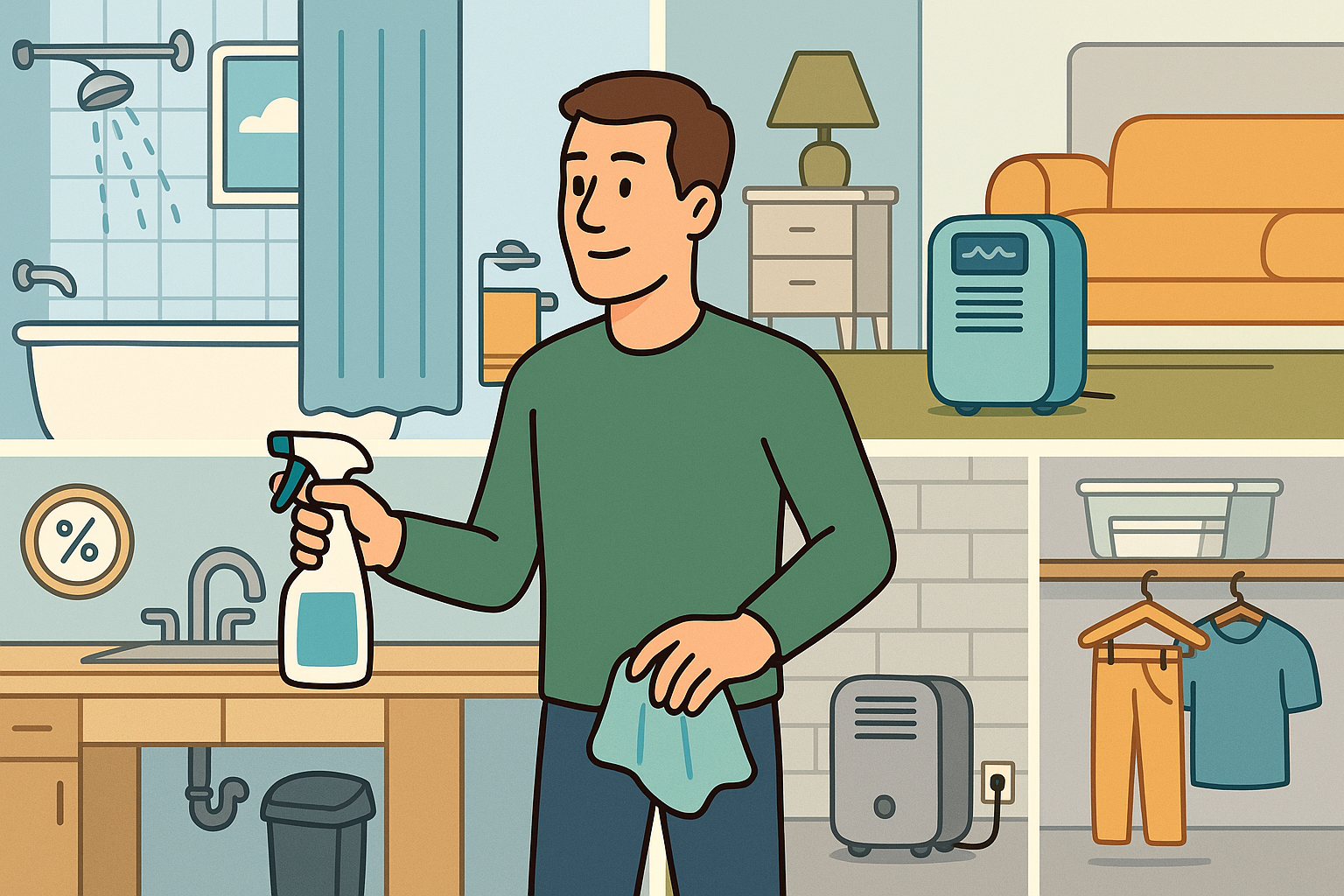
Reviewed By: Mold Safe Living Editorial Staff
Why Mold Prevention Starts With You
Mold can show up fast, and when it does, it can damage your health, belongings, and peace of mind. But here’s the good news: preventing mold is something you can control.
Many mold problems start quietly. A slow leak under the sink. Steamy showers with no ventilation. Damp clothes forgotten in the hamper. These small moisture issues can lead to big problems if ignored.
The best mold defense? Daily awareness. By learning a few simple habits and using affordable tools, you can make your home a place where mold struggles to grow.
Whether you're a renter or homeowner, this guide walks you through practical ways to reduce mold risks in every room.
Understanding What Causes Mold Growth
Mold needs four things to thrive: moisture, warmth, darkness, and organic material. That means any damp, enclosed space in your home can become a breeding ground.
Common triggers include:
Steamy showers and poor bathroom airflow
Leaks under sinks or behind walls
Cooking without ventilation
Hanging wet clothes indoors
Overflowing drip pans or clogged gutters
Once mold finds moisture, it spreads quickly, often in places you do not see until it becomes a major problem.
Here’s the bottom line: prevention is easier, cheaper, and safer than mold cleanup. By controlling moisture and improving airflow, you stop mold before it ever starts.
Top Mold-Prone Areas (and How to Prevent It in Each)
Different rooms face different risks. Here's how to tackle mold room by room.
Bathroom
Bathrooms are ground zero for mold because of all the steam and water. Here’s how to reduce the risk:
Run an exhaust fan during and after showers for at least 20 minutes
If no fan, open a window or door to let moisture escape
Wipe down walls and tiles after showering, especially corners
Wash bath mats and towels weekly
Scrub grout and seal tiles if needed
Kitchen
Cooking and cleaning in a small space generates heat and humidity. Mold often hides under sinks, near dishwashers, and behind appliances.
Use your stove’s vent when boiling water or frying
Clean spills quickly, especially near the sink
Wipe down cabinets under the sink
Check for leaks around your fridge and dishwasher
Empty the trash regularly to avoid organic buildup
Bedroom and Closets
These areas seem dry, but they can trap humidity—especially behind furniture and in tight closets.
Avoid overpacking closets; it restricts air circulation
Pull furniture slightly away from walls to allow airflow
Keep windows open occasionally to reduce trapped air
If your bedroom feels damp, use a small dehumidifier
Basement or Laundry Room
These lower-level areas often stay cool and humid, which mold loves.
Use a dehumidifier year-round if humidity is over 60%
Store seasonal items in plastic bins, not cardboard
Avoid hanging wet laundry indoors
Vent your dryer to the outside and clean the lint trap regularly
Also Read:
- Can Mold Make You Tired? What the Research Says
- Mold Prevention for Pet Owners in Apartments
- Why Your Closet Might Be Making You Sick
- Mold in Apartments: What Renters Need to Know
- Signs of Mold vs Dust or Dirt: How to Know What You’re Really Seeing
- How to Talk to Your Landlord About Mold
- Humidity and Mold: What’s a Safe Indoor Level?
Tools That Help Prevent Mold at Home
You do not need expensive gadgets. These affordable tools can make a big difference:
Hygrometer: A small humidity monitor that helps you track moisture levels. Keep indoor humidity between 30%–50%.
Dehumidifier: Pulls excess moisture from the air—great for basements, bathrooms, and bedrooms.
Moisture absorbers (like hanging packets or tubs): Place them in closets or under sinks.
Mold-resistant caulk or paint: Useful for bathrooms and kitchens during repairs.
Air purifiers with HEPA filters: These can trap mold spores already in the air.
Cleaning Habits That Discourage Mold
Staying clean helps mold stay away. Focus on these weekly routines:
Wipe down high-humidity areas like bathroom walls and kitchen counters
Use vinegar or hydrogen peroxide to clean surfaces (they fight mold naturally)
Sanitize sponges, towels, and bathroom rugs often these stay damp longer than we realize
Keep floors and corners dry, especially near entryways
Seasonal Mold Prevention Tips
Each season brings new challenges. Keep your home mold-free all year with these reminders:
Spring
Check for leaks after heavy rain
Reseal windows and doors if water leaks inside
Clean out window sills where moisture builds up
Summer
Clean and inspect A/C units and vents
Empty drip pans under the fridge or air conditioner
Use a dehumidifier in humid regions
Fall
Clear gutters to stop roof leaks
Inspect the basement or crawlspace for damp spots
Store seasonal clothes in dry, sealed containers
Winter
Wipe away window condensation
Do not over-humidify with a humidifier
Keep vents clear of dust and use ceiling fans to circulate air
When to Call for Help
Sometimes mold needs professional attention. Do not wait if:
You smell a musty odor but cannot see visible mold
Mold keeps coming back after cleaning
You discover a large area of mold (bigger than a sheet of paper)
You had a major leak or flood
When hiring a mold inspector, look for someone who uses moisture meters, thermal imaging, and provides a detailed report, not just a visual check.
Final Thoughts: Stay Ahead of the Mold
Preventing mold does not require fancy tools, just awareness, consistency, and a few small changes.
By spotting moisture early, improving airflow, and sticking to easy routines, you protect your health, your home, and your sense of calm.
Whether you rent or own, mold prevention starts with you, and a dry, clean space is always worth it.
